Page 56 of 394
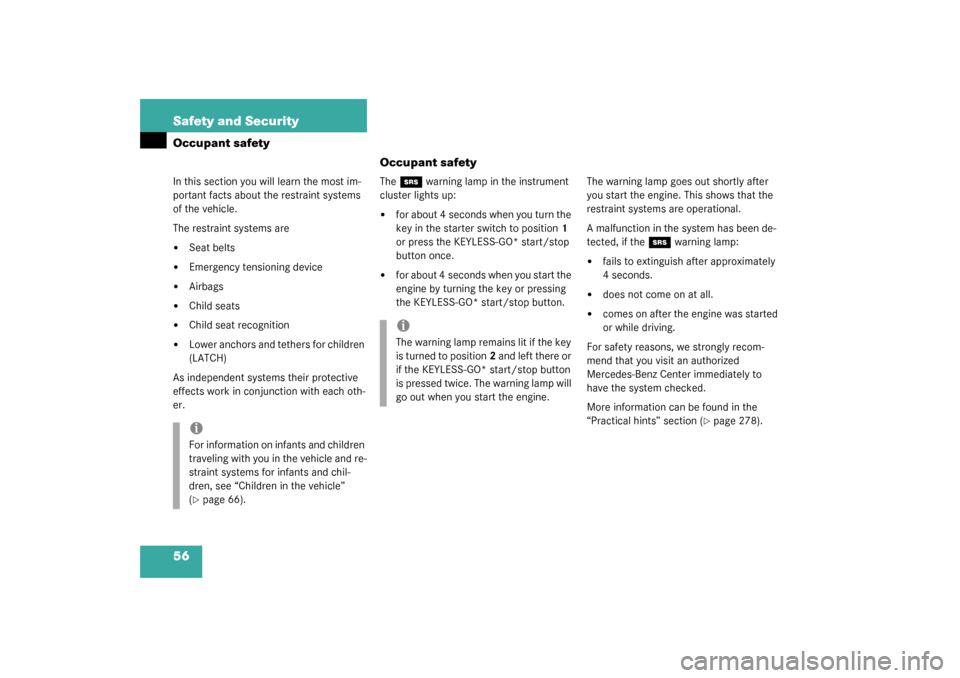
56 Safety and SecurityOccupant safety
Occupant safetyIn this section you will learn the most im-
portant facts about the restraint systems
of the vehicle.
The restraint systems are�
Seat belts
�
Emergency tensioning device
�
Airbags
�
Child seats
�
Child seat recognition
�
Lower anchors and tethers for children
(LATCH)
As independent systems their protective
effects work in conjunction with each oth-
er.The
1
warning lamp in the instrument
cluster lights up:
�
for about 4 seconds when you turn the
key in the starter switch to position1
or press the KEYLESS-GO* start/stop
button once.
�
for about 4 seconds when you start the
engine by turning the key or pressing
the KEYLESS-GO* start/stop button.The warning lamp goes out shortly after
you start the engine. This shows that the
restraint systems are operational.
A malfunction in the system has been de-
tected, if the
1
warning lamp:
�
fails to extinguish after approximately
4seconds.
�
does not come on at all.
�
comes on after the engine was started
or while driving.
For safety reasons, we strongly recom-
mend that you visit an authorized
Mercedes-Benz Center immediately to
have the system checked.
More information can be found in the
“Practical hints” section (
�page 278).
iFor information on infants and children
traveling with you in the vehicle and re-
straint systems for infants and chil-
dren, see “Children in the vehicle”
(�page 66).
iThe warning lamp remains lit if the key
is turned to position2 and left there or
if the KEYLESS-GO* start/stop button
is pressed twice. The warning lamp will
go out when you start the engine.
Page 62 of 394
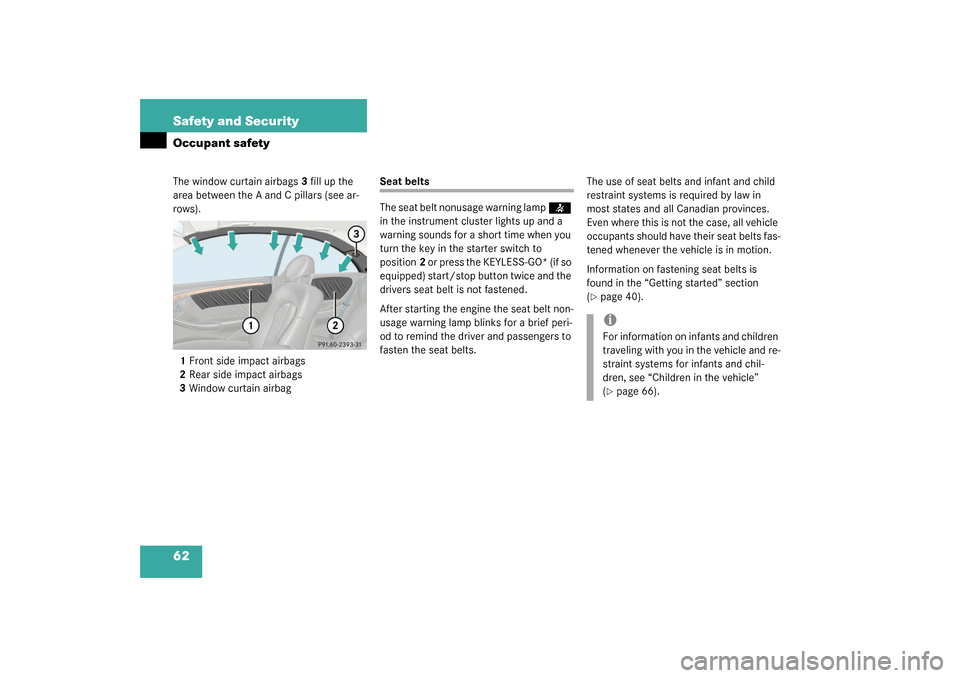
62 Safety and SecurityOccupant safetyThe window curtain airbags 3 fill up the
area between the A and C pillars (see ar-
rows).
1Front side impact airbags
2Rear side impact airbags
3Window curtain airbag
Seat belts
The seat belt nonusage warning lamp
<
in the instrument cluster lights up and a
warning sounds for a short time when you
turn the key in the starter switch to
position2 or press the KEYLESS-GO* (if so
equipped) start/stop button twice and the
drivers seat belt is not fastened.
After starting the engine the seat belt non-
usage warning lamp blinks for a brief peri-
od to remind the driver and passengers to
fasten the seat belts.The use of seat belts and infant and child
restraint systems is required by law in
most states and all Canadian provinces.
Even where this is not the case, all vehicle
occupants should have their seat belts fas-
tened whenever the vehicle is in motion.
Information on fastening seat belts is
found in the “Getting started” section
(
�page 40).iFor information on infants and children
traveling with you in the vehicle and re-
straint systems for infants and chil-
dren, see “Children in the vehicle”
(�page 66).
Page 75 of 394
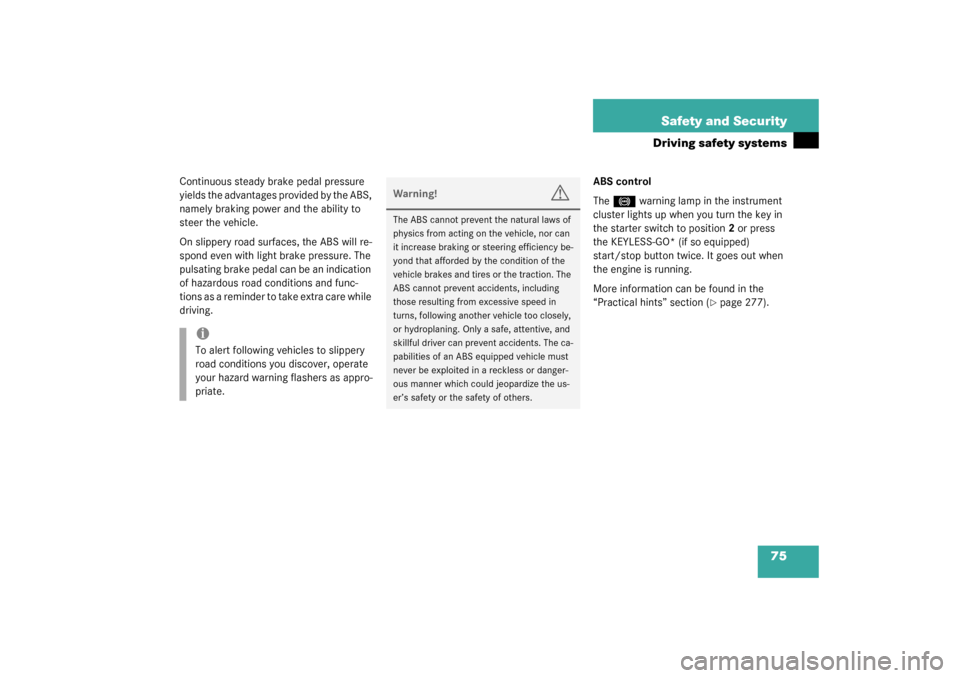
75 Safety and Security
Driving safety systems
Continuous steady brake pedal pressure
yields the advantages provided by the ABS,
namely braking power and the ability to
steer the vehicle.
On slippery road surfaces, the ABS will re-
spond even with light brake pressure. The
pulsating brake pedal can be an indication
of hazardous road conditions and func-
tions as a reminder to take extra care while
driving.ABS control
The
-
warning lamp in the instrument
cluster lights up when you turn the key in
the starter switch to position2 or press
the KEYLESS-GO* (if so equipped)
start/stop button twice. It goes out when
the engine is running.
More information can be found in the
“Practical hints” section (
�page 277).
iTo alert following vehicles to slippery
road conditions you discover, operate
your hazard warning flashers as appro-
priate.
Warning!
G
The ABS cannot prevent the natural laws of
physics from acting on the vehicle, nor can
it increase braking or steering efficiency be-
yond that afforded by the condition of the
vehicle brakes and tires or the traction. The
ABS cannot prevent accidents, including
those resulting from excessive speed in
turns, following another vehicle too closely,
or hydroplaning. Only a safe, attentive, and
skillful driver can prevent accidents. The ca-
pabilities of an ABS equipped vehicle must
never be exploited in a reckless or danger-
ous manner which could jeopardize the us-
er’s safety or the safety of others.
Page 76 of 394
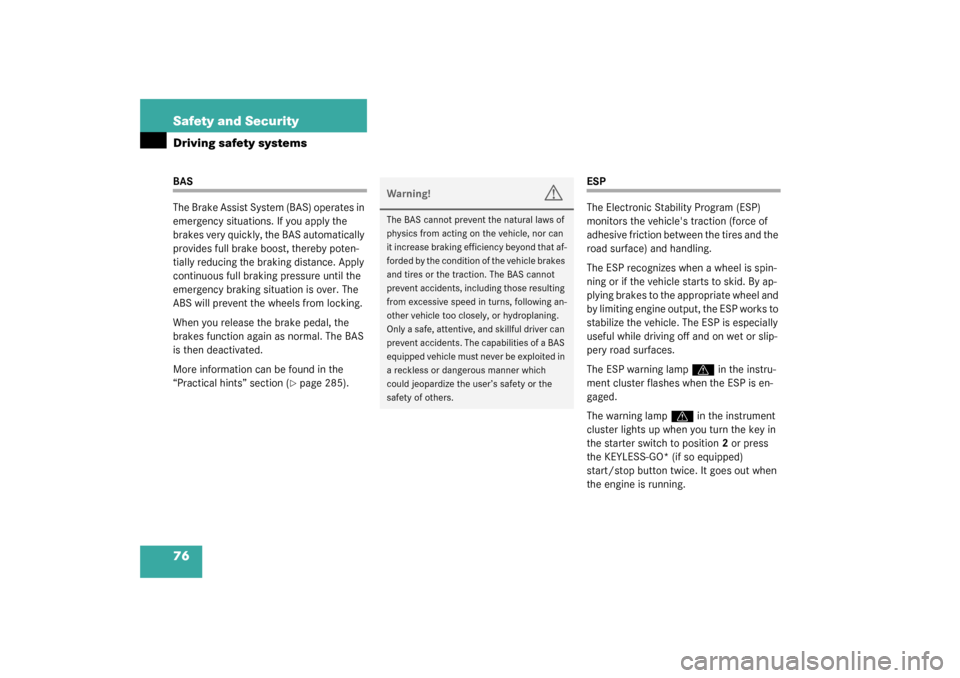
76 Safety and SecurityDriving safety systemsBAS
The Brake Assist System (BAS) operates in
emergency situations. If you apply the
brakes very quickly, the BAS automatically
provides full brake boost, thereby poten-
tially reducing the braking distance. Apply
continuous full braking pressure until the
emergency braking situation is over. The
ABS will prevent the wheels from locking.
When you release the brake pedal, the
brakes function again as normal. The BAS
is then deactivated.
More information can be found in the
“Practical hints” section (
�page 285).
ESP
The Electronic Stability Program (ESP)
monitors the vehicle's traction (force of
adhesive friction between the tires and the
road surface) and handling.
The ESP recognizes when a wheel is spin-
ning or if the vehicle starts to skid. By ap-
plying brakes to the appropriate wheel and
by limiting engine output, the ESP works to
stabilize the vehicle. The ESP is especially
useful while driving off and on wet or slip-
pery road surfaces.
The ESP warning lamp
v
in the instru-
ment cluster flashes when the ESP is en-
gaged.
The warning lamp
v
in the instrument
cluster lights up when you turn the key in
the starter switch to position2 or press
the KEYLESS-GO* (if so equipped)
start/stop button twice. It goes out when
the engine is running.
Warning!
G
The BAS cannot prevent the natural laws of
physics from acting on the vehicle, nor can
it increase braking efficiency beyond that af-
forded by the condition of the vehicle brakes
and tires or the traction. The BAS cannot
prevent accidents, including those resulting
from excessive speed in turns, following an-
other vehicle too closely, or hydroplaning.
Only a safe, attentive, and skillful driver can
prevent accidents. The capabilities of a BAS
equipped vehicle must never be exploited in
a reckless or dangerous manner which
could jeopardize the user’s safety or the
safety of others.
Page 78 of 394
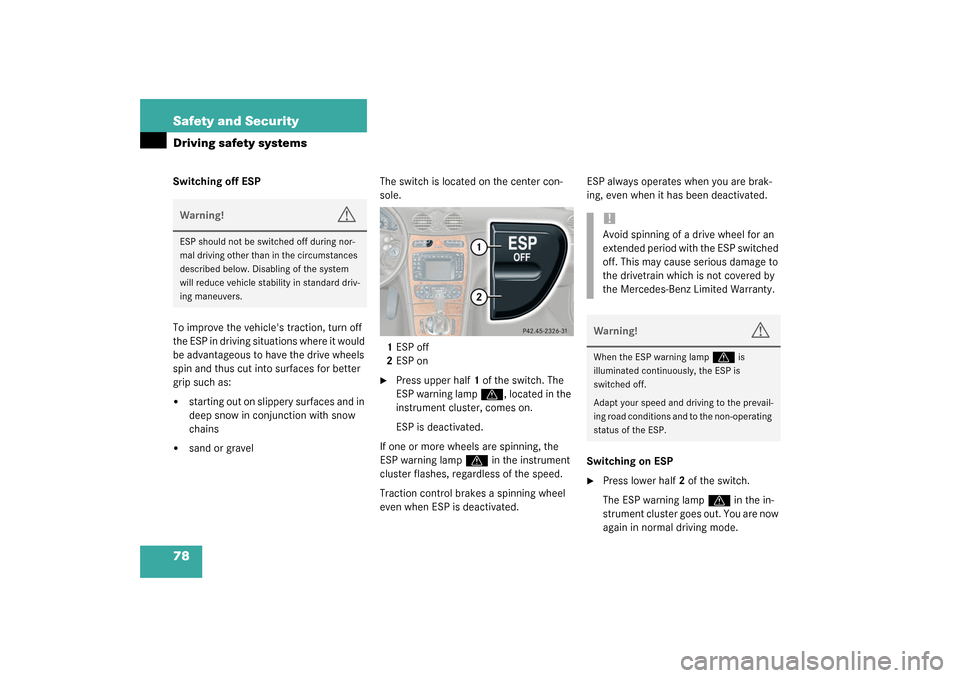
78 Safety and SecurityDriving safety systemsSwitching off ESP
To improve the vehicle's traction, turn off
the ESP in driving situations where it would
be advantageous to have the drive wheels
spin and thus cut into surfaces for better
grip such as:�
starting out on slippery surfaces and in
deep snow in conjunction with snow
chains
�
sand or gravelThe switch is located on the center con-
sole.
1ESP off
2ESP on
�
Press upper half1 of the switch. The
ESP warning lamp
v
, located in the
instrument cluster, comes on.
ESP is deactivated.
If one or more wheels are spinning, the
ESP warning lamp
v
in the instrument
cluster flashes, regardless of the speed.
Traction control brakes a spinning wheel
even when ESP is deactivated.ESP always operates when you are brak-
ing, even when it has been deactivated.
Switching on ESP
�
Press lower half2 of the switch.
The ESP warning lamp
v
in the in-
strument cluster goes out. You are now
again in normal driving mode.
Warning!
G
ESP should not be switched off during nor-
mal driving other than in the circumstances
described below. Disabling of the system
will reduce vehicle stability in standard driv-
ing maneuvers.
!Avoid spinning of a drive wheel for an
extended period with the ESP switched
off. This may cause serious damage to
the drivetrain which is not covered by
the Mercedes-Benz Limited Warranty.Warning!
G
When the ESP warning lamp
v
is
illuminated continuously, the ESP is
switched off.
Adapt your speed and driving to the prevail-
ing road conditions and to the non-operating
status of the ESP.
Page 83 of 394
83 Controls in detail
Locking and unlocking
Seats
Memory function
Lighting
Instrument cluster
Control system
Automatic transmission
Good visibility
Automatic climate control
Audio system
Power windows
Sliding/pop-up roof*
Driving systems
Loading
Useful features
Page 100 of 394
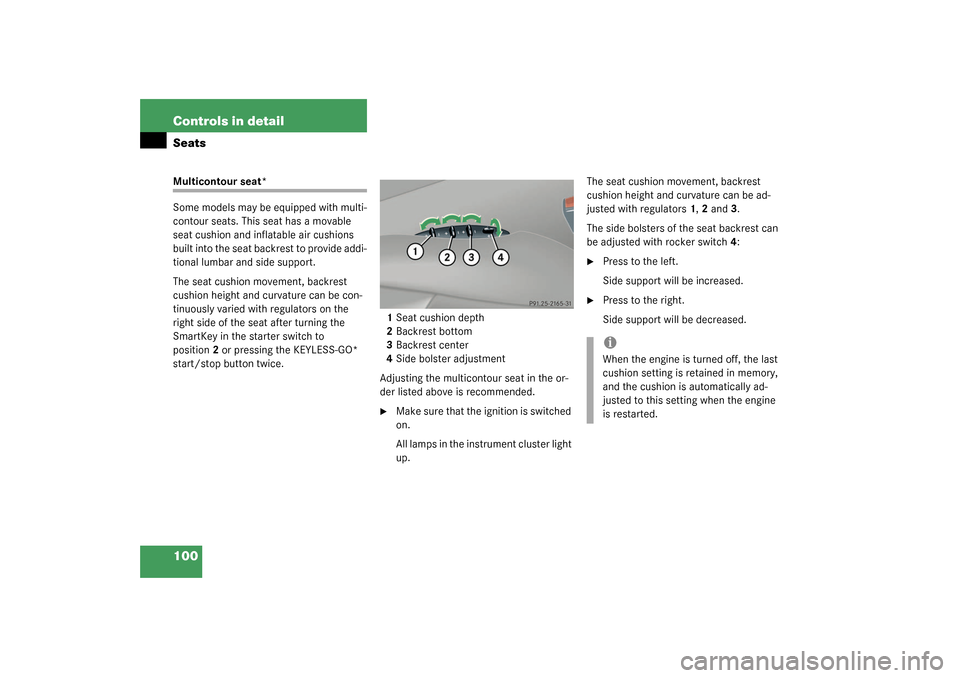
100 Controls in detailSeatsMulticontour seat*
Some models may be equipped with multi-
contour seats. This seat has a movable
seat cushion and inflatable air cushions
built into the seat backrest to provide addi-
tional lumbar and side support.
The seat cushion movement, backrest
cushion height and curvature can be con-
tinuously varied with regulators on the
right side of the seat after turning the
SmartKey in the starter switch to
position2 or pressing the KEYLESS-GO*
start/stop button twice.1Seat cushion depth
2Backrest bottom
3Backrest center
4Side bolster adjustment
Adjusting the multicontour seat in the or-
der listed above is recommended.
�
Make sure that the ignition is switched
on.
All lamps in the instrument cluster light
up.The seat cushion movement, backrest
cushion height and curvature can be ad-
justed with regulators1, 2 and3.
The side bolsters of the seat backrest can
be adjusted with rocker switch4:
�
Press to the left.
Side support will be increased.
�
Press to the right.
Side support will be decreased.iWhen the engine is turned off, the last
cushion setting is retained in memory,
and the cushion is automatically ad-
justed to this setting when the engine
is restarted.
Page 101 of 394
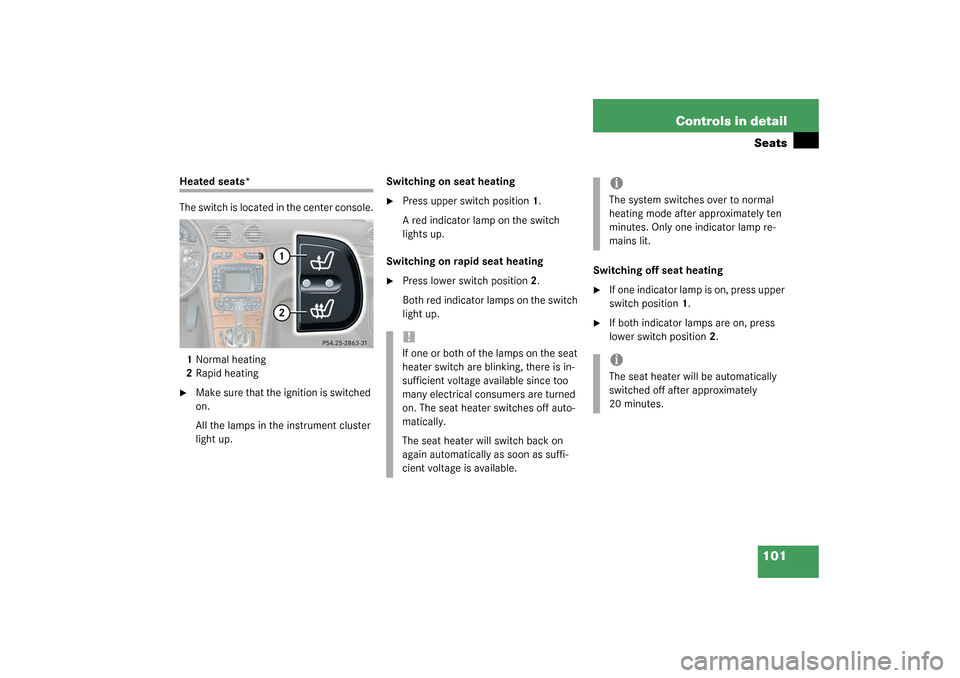
101 Controls in detailSeats
Heated seats*
The switch is located in the center console.
1Normal heating
2Rapid heating�
Make sure that the ignition is switched
on.
All the lamps in the instrument cluster
light up.Switching on seat heating
�
Press upper switch position1.
A red indicator lamp on the switch
lights up.
Switching on rapid seat heating
�
Press lower switch position2.
Both red indicator lamps on the switch
light up.Switching off seat heating
�
If one indicator lamp is on, press upper
switch position1.
�
If both indicator lamps are on, press
lower switch position2.
!If one or both of the lamps on the seat
heater switch are blinking, there is in-
sufficient voltage available since too
many electrical consumers are turned
on. The seat heater switches off auto-
matically.
The seat heater will switch back on
again automatically as soon as suffi-
cient voltage is available.
iThe system switches over to normal
heating mode after approximately ten
minutes. Only one indicator lamp re-
mains lit. iThe seat heater will be automatically
switched off after approximately
20 minutes.